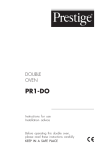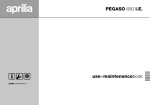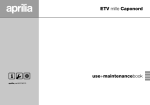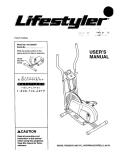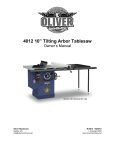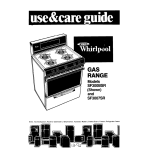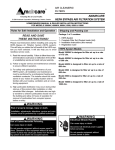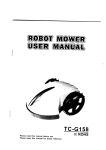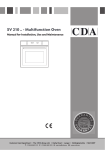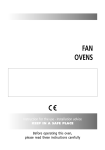Download PR1-SO - Partmaster
Transcript
MULTI-FUNCTION OVEN PR1-SO Instructions for use Installation advice Before operating this oven, please read these instructions carefully KEEP IN A SAFE PLACE Dear Customer, Thank you for purchasing a Prestige Oven. The safety precautions and recommendations within this booklet are for your own safety and that of others. They will also provide a means by which to make full use of the features offered by your appliance. Please preserve this booklet carefully. It may be useful in future, either to yourself or to others in the event that doubts should arise relating to its operation. This appliance must be used only for the task it has explicitly been designed for, that is for cooking foodstuffs. Any other form of usage is to be considered as inappropriate and therefore dangerous. The manufacturer declines all responsibility in the event of damage caused by improper, incorrect or illogical use of the appliance. IMPORTANT INFORMATION FOR CORRECT DISPOSAL OF THE PRODUCT IN ACCORDANCE WITH EC DIRECTIVE 2002/96/EC. At the end of its working life, the product must not be disposed of as urban waste. It must be taken to a special local authority differentiated waste collection centre or to a dealer providing this service. Disposing of a household appliance separately avoids possible negative consequences for the environment and health deriving from inappropriate disposal and enables the constituent materials to be recovered to obtain significant savings in energy and resources. As a reminder of the need to dispose of household appliances separately, the product is marked with a crossed-out wheeled dustbin. DECLARATION OF CE CONFORMITY – This oven has been designed to be used only for cooking. Any other use (such as heating a room) is improper and dangerous. – This oven has been designed, constructed, and marketed in compliance with: - Safety requirements of the “Low voltage” Directive 2006/95/EC; - Safety requirements of the “EMC” Directive 89/336/EC; - Requirements of EEC Directive 93/68. 2 BEFORE USING FOR THE FIRST TIME • Read the instructions carefully before installing and using the appliance. • After unpacking the appliance, check that it is not damaged. In case of doubt, do not use the appliance and contact your supplier or a qualified engineer. • Remove all the packing materials (i.e. plastic bags, polystyrene foam, etc.) and do not leave it around within easy reach of children, as these may cause serious injuries. The packaging materials are recyclable. • Do not attempt to modify the technical characteristics of the appliance, as it may become dangerous to use. • The appliance should be installed and all the electrical connections made by a qualified engineer in compliance with local regulations in force and following the manufacturer's instructions. IMPORTANT PRECAUTIONS AND RECOMMENDATIONS FOR USE OF ELECTRICAL APPLIANCES Use of any electrical appliance implies the necessity to follow a series of fundamental rules. In particular: • Never touch the appliance with wet hands or feet; • do not operate the appliance barefooted; • do not allow children or disabled people to use the appliance without your supervision. The manufacturer cannot be held responsible for any damages caused by improper, incorrect or unreasonable use of the appliance. USING THE DOUBLE OVEN FOR THE FIRST TIME You are advised to carry out the following operations: • Assemble the interior of the oven as described under the heading “Cleaning and maintenance” • Switch the empty oven ON at maximum temperature for about two hours to eliminate traces of grease and smell from the components. • Let the oven cool down, switch off the electrical supply, then clean the inside of the oven with a cloth soaked in water and neutral detergent and dry thoroughly. 3 IMPORTANT SAFEGUARDS & RECOMMENDATIONS • Do not carry out any cleaning or maintenance without first disconnecting the appliance from the electrical supply. • During and after use of the oven, certain parts will become very hot. Do not touch hot parts. • After use always ensure that the control knobs are in the OFF position. • Keep children away from the oven during use. • Do not allow young children or infirm persons to use the appliance without your supervision. • WARNING When correctly installed, your product meets all safety requirements laid down for this type of product category. However special care should be taken around the rear or the underneath of the appliance as these areas are not designed or intended to be touched and may contain sharp or rough edges, that may cause injury. • Fire Risk! Do not store inflammable materials inside the oven. • Always use oven gloves when removing the shelves and food trays from the oven whilst hot. • Do not line the oven walls with aluminium foil. Do not place baking trays or the drip tray on the base of the oven chamber. • Clean the oven regularly and do not allow fat or oils to build up in the oven base or trays. Remove spillages as soon as they occur. • Always stand back from the oven when opening the oven door to allow steam and hot air to escape before removing the food. • Do not hang towels, dishcloths or other items on the cooker or its handle – as this could be a fire hazard. • Make sure that electrical cords connecting other appliances in the proximity cannot become entrapped in the oven door. • Before disposing of an unwanted appliance, it is recommended that it is made inoperative and that all potentially hazardous parts are made harmless. • Important: This appliance has been designed for domestic use only. The appliance is NOT suitable for use within a semi-commercial, commercial or communal environment. • Safe food handling: leave food in the oven for as short a time as possible before and after cooking. This is to avoid contamination by organisms which may cause food poisoning. Take particular care during warmer weather. 4 1 CONTROL PANEL 5 2 4 3 1 Fig. 1.1 CONTROL PANEL 1. 2. 3. 4. 5. Function selector knob Oven thermostat knob Electronic programmer Power on indicator lamp Oven temperature indicator lamp NB: Your appliance has been fitted with a cooling fan to achieve optimum efficiency of the controls and to ensure lower surface temperatures are maintained. The cooling fan is thermostatically controlled and will operate when the oven is turned on and will continue to be heard running for a short period of time until the oven cavity has cooled down to a predetermined level. THERMOSTAT The temperature range of the thermostat is 50-250 Deg C Fig. 1.2 5 2 HOW TO USE THE OVEN GENERAL FEATURES OPERATING PRINCIPLES As its name indicates, this is an oven that presents particular features from an operational point of view. In fact, it is possible to insert 7 different programs to satisfy every cooking need. The 7 positions, thermostatically controlled, are obtained by 4 heating elements which are: Heating and cooking in the MULTIFUNCTION oven are obtained in the following ways: • • • • Lower element Upper element Grill element Circular element 1300 1000 2000 2200 W W W W NOTE: Before using for the first time, it is advisable to operate the oven at the maximum temperature (thermostat knob on position 250) for 60 minutes in the position to eliminate possiand ble traces of grease on the heating elements. Repeat the operation for another 15 minutes with the grill element on as explained in the chapters GRILLING and USE OF THE GRILL. WARNING: The door is hot, use the handle. During use the appliance becomes hot. Care should be taken to avoid touching heating elements inside the oven. a. by normal convection The heat is produced by the upper and lower heating elements. b. by forced convection A fan sucks in the air contained in the oven, which circulates it through the circular heating element and then forced back into the oven by the fan. Before the hot air is sucked back again by the fan to repeat the described cycle, it envelops the food in the oven, provoking a complete and rapid cooking. It is possible to cook several dishes simultaneously. c. by semi-forced convection The heat produced by the upper and lower heating elements is distributed throughout the oven by the fan. d. by radiation The heat is radiated by the infra red grill element. e. by radiation and ventilation The radiated heat from the infra red grill element is distributed throughout the oven by the fan. f. by ventilation The food is defrosted by using the fan only function without heat. Attention: the oven door becomes very hot during operation. Keep children away. 6 THERMOSTAT KNOB (fig. 2.1) To turn on the heating elements of the oven, set function selector knob to the required position and the thermostat knob to the desired temperature. To set the temperature, turn the thermostat control knob indicator mark to the required temperature. The elements will turn on or off automatically which is determined by the thermostat. The operation of the heating elements is signalled by a light placed on the control panel. FUNCTION SELECTOR KNOB (fig. 2.2) Rotate the knob clockwise to set the oven to one of the following functions: OVEN LIGHT AND COOLING FAN By turning the function selector knob to this setting, the cooling fan will operate and the oven light will illuminate in the oven cavity (15W). The oven light and cooling fan will operate on all selected functions. TRADITIONAL CONVECTION COOKING The upper and lower heating elements are switched on. The heat is diffused by natural convection and the temperature must be regulated between 50°C and the maximum position with the thermostat knob. It is necessary to preheat the oven before introducing the foods to be cooked. Recommended for: For foods which require the same cooking temperature both internally and externally, i. e. roasts, spare ribs, meringue, etc. Fig. 2.1 Fig. 2.2 7 GRILLING The infra-red heating element is switched on. The heat is diffused by radiation. Use with the oven door closed and the thermostat knob must be regulated between 50°C and 200°C maximum. For correct use see chapter “USE OF THE GRILL”. Recommended for: Intense grilling action for cooking with the broiler; browning, crisping, “au gratin”, toasting, etc. DEFROSTING FROZEN FOODS Only the oven fan is on. To be used with the thermostat knob in the off “●” position because the other positions have no effect. The defrosting is done by simple ventilation without heat. Recommended for: To rapidly defrost frozen foods; 1 kilogram requires about one hour. The defrosting times vary according to the quantity and type of foods to be defrosted. HOT AIR COOKING The circular element and the fan are on. The heat is diffused by forced convection and the temperature must be regulated between 50°C and the maximum position with the thermostat knob. It is not necessary to preheat the oven. Recommended for: For foods that must be well done on the outside and tender or rare on the inside, i. e. lasagna, lamb, roast beef, whole fish, etc. VENTILATED GRILL COOKING The infra-red grill and the fan are on. The heat is mainly diffused by radiation and the fan then distributes it throughout the oven. The temperature must be regulated between 50°C and 190°C maximum with the thermostat knob. It is necessary to preheat the oven for about 5 minutes. For correct use see chapter “GRILLING AND AU GRATIN. Always grill with the oven door closed. 8 Recommended for: For grill cooking when a fast outside browning is necessary to keep the juices in, i. e. veal steak, steak, hamburger, etc. MAINTAINING TEMPERATURE AFTER COOKING OR SLOWLY HEATING FOODS The upper element and the circular element connected in series, are switched on; also the fan is on. The heat is diffused by forced convection with the most part being produced by the upper element. The temperature must be regulated between 50° and 150 °C with the thermostat knob. Recommended for: To keep foods hot after cooking. To slowly heat already cooked foods. CONVECTION COOKING WITH VENTILATION The upper and lower heating elements and the fan turn on. The heat coming from the top and bottom is diffused by forced convection. The temperature must be regulated between 50°C and the maximum position with the thermostat knob. Recommended for: For foods of large volume and quantity which require the same internal and external degree of cooking; for ex: rolled roasts, turkey, legs, cakes, etc. COOKING ADVICE STERILIZATION Sterilization of foods to be conserved, in full and hermetically sealed jars, is done in the following way: a. Set the function selector switch to position . b. Place the thermostat knob to position 185 °C and preheat the oven. c. Fill the grill pan with hot water. d. Set the jars into the grill pan making sure they do not touch each other and the door and set the thermostat knob to position 135 °C. When sterilization has begun, that is, when the contents of the jars start to bubble, turn off the oven and leave to cool. REGENERATION Set the function selector switch to position and the thermostat knob to position 150° C. Bread becomes fragrant again if wet with a few drops of water and put into the oven for about 10 minutes. ROASTING To obtain classical roasting, it is necessary to remember: • that it is advisable to maintain a temperature between 180 and 200 °C. • that the cooking time depends on the quantity and the type of foods. The external parts of the oven become hot during operation. Keepchildren well out of reach. 9 COOKING DIFFERENT DISHES AT THE SAME TIME With the function selector in position the ventilated oven allows you to cook different types of food at the same time. Fish, cakes and meat can be cooked together without the smells and flavours mixing. The only precautions required are the following: • The cooking temperatures must be as close as possible with a maximum difference of 20° - 25°C between the different foods. • Different dishes must be placed in the oven at different times according to the cooking time required for each one. This type of cooking obviously provides a considerable saving on time and energy. GRILLING AND “AU GRATIN” Grilling may be done by selecting grill+fan setting with the function selector knob, because the hot air completely envelops the food that is to be cooked. Set the thermostat knob between 50°C and 190°C maximum and after having preheated the oven, simply place the food on the grid. Close the door and let the oven operate until grilling is done. Adding a few dabs of butter before the end of the cooking time gives the golden “au gratin” effect. Always grill with the oven door closed. It is recommended that you do not grill for longer than 30 minutes at any one time. Attention: the oven door becomes very hot during operation. Keep children away. 10 USE OF THE GRILL Set the function selector knob to position and the thermostat knob between 50°C and 200°C max. Leave to warm up for approximately 5 minutes with the door closed. Introduce the food to be cooked, positioning the grill pan as close to the grill as possible. Always grill with the oven door closed. Grilling with the oven door closed and not for longer than 30 minutes at any one time. Attention: the oven door becomes very hot during operation. Keep children away. 3 ELECTRONIC PROGRAMMER The electronic programmer is a device which groups together the following functions: • 24 hours clock with illuminated display • Timer (up to 23 hours and 59 minutes) • Program for automatic oven cooking • Program for semi-automatic oven cooking. Description of the buttons: Description of the illuminated symbols: AUTO - flashing - Programmer in automatic position but not programmed AUTO - always lit - Programmer in automatic position with program set. Automatic cooking taking place Timer in operation Timer Cooking time End of cooking time Manual position and cancellation of the set cooking program Advance the time for of all programs Decrease the program time and changing the frequency of the audible signal. and AUTO - flashing - Program error. (The time of day lies between the calculated cooking start and end time). Note: Select a function by the respective button and, within 5 seconds, set the required time with the / buttons (“one-hand” operation). A power cut makes the clock go to zero and cancels the set programs. A U T O Fig. 3.1 Fig. 3.2 11 ELECTRONIC CLOCK (fig. 3.2) The programmer is equipped with an electronic clock with an illuminated display which indicates hours and minutes. Upon immediate connection of the oven or after a powercut, three zeros will flash on the display panel. To set the hour it is necessary to push the button and then the or button until you have set the exact hour (fig. 3.2). Another way is to simultaneously push the two buttons and at the same time push the or button. Note: The hour setting deletes any program. NORMAL COOKING WITHOUT THE USE OF THE PROGRAMMER To manually use the oven, that is, without the aid of the programmer, it is necessary to cancel the flashing AUTO by pushing the button (AUTO will be switched off and the symbol will go on - Fig. 3.3). ELECTRONIC TIMER The timer program consists only of a buzzer which may be set for a maximum period of 23 hours and 59 minutes. If the AUTO is flashing push the button. To set the time, push the button and the or until you obtain the desired time in the panel (fig. 3.4). Having finished the setting, the clock hour will appear on the panel and the symbol will be lit. The countdown will start immediately and may be seen at any moment on the panel by simply pressing the button . At the end of the time, the symbol will be switched off and an intermittent buzzer will go off; this can be stopped by pressing any of the buttons. SETTING THE FREQUENCY OF THE AUDIBLE SIGNAL 3 possible sounds can be selected by pressing the button. Attention: If the AUTO is steadily lit (which means a cooking program has already been set), the program can be cancelled and switched to manual by pushing the button . If the oven is switched on, you must switch off manually. A U T O 12 Fig. 3.3 Fig. 3.4 AUTOMATIC OVEN COOKING To cook food automatically in the oven, it is necessary to: 1. Set the length of the cooking time 2. Set the end of the cooking time 3. Set the temperature and the oven cooking program. 1. Set the length of the cooking time required by pushing the button and the button to advance, or to go back if you have passed the desired time (fig. 3.5). The AUTO and the symbol will be on. 2. Set the time you need the food to stop cooking by pushing the button (the cooking time already added to the clock time will appear), and the button (fig. 3.6); if you pass the desired time you can go back by pushing the button. After this setting, the symbol will go off. If after this setting, the AUTO flashes on the panel and a buzzer goes off, it means there was an error in the programming, that is the cooking cycle has been superimposed on the clock. In this case, change the end of cooking time or the cooking time itself by following the instructions above. 3. Set the temperature and the cooking program (see the relevant sections). Once the oven is programmed it will switch on automatically at the right time to stop the cooking at the desired end time. During cooking, the symbol remains on. By pushing the button you can see the time that remains until the end of cooking. The cooking program may be cancelled at any time by pushing . At the end of the cooking time the oven will turn off automatically, the symbol will turn off, AUTO will flash and the buzzer will sound, which can be turned off by pushing any of the buttons. Turn the switch and temperature knobs to "OFF" and put the programmer onto “manual” by pressing the button. Attention: A powercut will make the clock go to zero and will cancel the set programs. After a powercut, three zeros will flash on the panel. A U T O Fig. 3.5 A U T O Fig. 3.6 13 SEMI - AUTOMATIC COOKING This is used to switch the oven off automatically after the desired cooking time has elapsed. There are two ways to set the semiautomatic cooking function: 1. Set the length of time you need to cook the food by pushing the button and the button to advance, or to go backwards (Fig. 3.7). This sets the desired “stop” time. At the end of the cooking, the oven and the symbol will turn off, the AUTO will flash and a buzzer will go off which can be stopped by pushing any of the buttons. Turn the switch and temperature knobs to "OFF" and put the programmer onto “manual” by pressing the button. or 2.Set the time you need the food to stop cooking by pushing the button and the button to advance, or to go backwards if you have passed the desired time (Fig. 3.8). AUTO and the symbol will be on. Then set the temperature and the cooking program (see the relevant sections). The oven is switched on and it will switch off automatically at the end of the desired time. During cooking, the symbol remains on and by pressing the button you can see the time that remains until the end of the cooking. The cooking program can be cancelled at any moment by pushing the button. A U T O Fig. 3.7 A U T O 14 Fig. 3.8 4 CLEANING AND MAINTENANCE GENERAL ADVICE INSIDE OF OVEN Important: Before any operation of cleaning and maintenance disconnect the appliance from the electrical supply. The oven should always be cleaned after use when it has cooled down. The cavity should be cleaned using a mild detergent solution and warm water. Suitable proprietary chemical cleaners may be used after first consulting with the manufacturers recommendations and testing a small sample of the oven cavity. Abrasive cleaning agents or scouring pads/cloths should not be used on the cavity surface. It is advisable to clean when the appliance is cold and especially for cleaning the enamelled parts. Avoid leaving alcaline or acidic substances (lemon juice, vinegar, etc.) on the surfaces. Avoid using cleaning products with a chlorine or acidic base. The oven must always be cleaned after every use, using suitable products. STAINLESS STEEL AND ALUMINIUM PARTS AND SILK-SCREEN PRINTED SURFACES NOTE: The manufacturers of this appliance will accept no responsibility for damage caused by chemical or abrasive cleaning. Let the oven cool down and pay special attention no to touch the hot heating elements inside the oven cavity. Clean using an appropriate product. Always dry thoroughly. IMPORTANT: these parts must be cleaned very carefully to avoid scratching and abrasion. You are advised to use a soft cloth and neutral soap. ENAMELLED PARTS All the enamelled parts must be cleaned with a sponge and soapy water only or other non-abrasive products. Dry preferably with a microfibre or soft cloth. WARNING When correctly installed, your product meets all safety requirements laid down for this type of product category. However special care should be taken around the rear or the underneath of the appliance as these areas are not designed or intended to be touched and may contain sharp or rough edges, that may cause injury. Do not store flammable material in the oven. Do not use harsh abrasive cleaners or sharp metal scrapers to clean the oven door glass since they can scratch the surface, which may result in shattering of the glass. Do not use a steam cleaner because the moisture can get into the appliance thus make it unsafe. 15 WIRE RACKS REPLACING THE OVEN LIGHT • Assemble the wire racks to the oven walls using the 2 screws (Fig. 4.1). • Slide into the guides, the shelf and the tray (fig. 4.2). The shelf must be fitted so that the safety catch, which stops it sliding out, faces the inside of the oven. • To dismantle, operate in reverse order. Before any maintenance is started involving electrical parts of the appliance, it must be disconnected from the power supply. • Let the oven cavity and the heating elements cool down; • Switch off the electrical supply; – Unscrew the protective cover (fig. 4.3); • Unscrew and replace the bulb with a new one suitable for high temperatures (300°C) having the following specifications: 230-240V 50 Hz, 15W, E14. • Refit the protective cover. NOTE: Oven bulb replacement is not covered by your guarantee. Fig. 4.1 2 Fig. 4.2 16 Fig. 4.3 1 REMOVING THE OVEN DOOR The oven door can easily be removed as follows: • Open the door to the full extent (fig. 4.5a). • Open the lever “A” completely on the left and right hinges (fig. 4.5b). Fig. 4.5a • Hold the door as shown in fig. 4.5. • Gently close the door (fig. 4.5c) until left and right hinge levers “A” are hooked to part “B” of the door (fig. 4.5b) A B • Withdraw the hinge hooks from their location following arrow “C” (fig. 4.5d). • Rest the door on a soft surface. • To replace the door, repeat the above steps in reverse order. Fig. 4.5b Fig. 4.5c C Fig. 4.5 Fig. 4.5d 17 ADVICE FOR THE INSTALLER IMPORTANT • Appliance installation and maintenance must only be carried out by QUALIFIED TECHNICIANS and in compliance with the local safety standards. Failure to observe this rule will invalidate the warranty. • Always unplug the appliance before carrying out any maintenance operations or repairs. • The walls surrounding the oven must be made of heat-resistant material. • Taking care NOT to lift the oven by the door handle. 18 5 INSTALLATION The oven can be fitted in standard units, width and depth 60 cm. Installation requires a compartment as illustrated in figures 5.1 and 5.2. On the lower side, the oven must lay on supports standing the oven weight. Using 4 screws (not supplied) the oven can be secured to the oven housing. 50 • The appliance must be housed in heat resistant units. 560 585 • The walls of the units must be capable of resisting temperatures of 75 °C above room temperature. WARNING When correctly installed, your product meets all safety requirements laid down for this type of product category. However special care should be taken around the rear or the underneath of the appliance as these areas are not designed or intended to be touched and may contain sharp or rough edges, that may cause injury. Fig. 5.1 560 min 591 536 594 in 0m 55 0 54 594 20 Fig. 5.2 19 50 mm ; ; 600 ;; 30 mm 50 Fig. 5.3 550 Fig. 5.4 To ensure internal ventilation, aeration channels must be provided as illustrated in the figures 5.3 and 5.4. The walls surrounding the oven must be made of heat-resistant material. Taking care NOT to lift the oven by the door handle. 20 OVEN DOOR LOWER TRIM AIR FLOW Fig. 5.5 IMPORTANT: To avoid damage to the lower trim please note the following instructions. The lower trim is designed to allow for good air circulation and the correct opening of the oven door. To ensure the trim is not damaged due to the appliance being placed on the floor, the appliance should be suitably supported as in above illustrations. After installation the appliance door should be slowly opened to ensure no damage has occurred. No responsibility for lower trim damage will be accepted if these instructions have not been followed. 21 6 ELECTRICAL CONNECTION Important For your safety please read the following information The wires in the mains lead on this appliance are coloured in accordance with the following code: Green and Yellow - Earth Blue – Neutral Brown – Live Warning: This appliance must be earthed. • The appliance must be connected to a 220-240 volts 50 cycle AC supply by means of a three pin socket, suitably earthed and should be protected by a 13 amp fuse in the plug or a 15 amp fuse in the consumer unit. • The appliance is supplied with a rewireable 13 amp 3 pin plug fitted with a 13amp fuse. Should the fuse require replacement, it must be replaced with a fuse rated at 13 amp and approved to BS1362. • If the mains plug is unsuitable for the socket outlet in your home or is removed for any other reason, then the cut off plug should be disposed of safely to prevent the hazard of electric shock. • There is a danger of electric shock if the cut off plug is inserted into any 13 amp socket outlet. • How to wire a 13 amp plug. 22 ELECTRICAL SECTION • As the colours may not correspond with the markings identifying the terminals in your plug proceed as follows. • The green and yellow wire must be connected to the terminal in the plug which is marked with the letter E or with the earth symbol or coloured green and yellow. • The blue wire must be connected to the terminal marked N or coloured black. • The brown wire must be connected to the terminal marked L or coloured red. Fig. 6.1 Your Prestige from COMET Your new Prestige product comes with 12-month guarantee covering all parts and labour. If your appliance proves to be defective as a result of faulty materials or workmanship during the guarantee COMET will repair or replace it free of charge. AFTER SALES SERVICE Should you require to book a service call. Please Telephone 08705 425425. For product information and advice. Please Telephone 0113 2793520. 1. The right and benefits under this guarantee are additional to your statutory rights, which are not affected by this guarantee. 2. COMET undertakes within the specified period, to repair or replace free of charge any parts of the appliance found to be defective provided this: • We are promptly informed of the defect. • The appliance is installed and used in accordance with the written instructions enclosed with the appliance. • The appliance is used only on an electrical supply as indicated on the rating label fixed to the appliance. • The appliance has not been altered in any way or subject to misuse or repair by a person other than an authorised service agent for COMET. 3. No rights are given under this guarantee to a person acquiring the appliance second hand or for commercial or communal use. 4. This guarantee applies throughout the UK Channel Islands. 5. Any replaced parts shall be the property of COMET. 6. Any repaired or replacement appliances will be guaranteed on these terms for the unexpired portion of the guarantee. Descriptions and illustrations in this booklet are given as simply indicative. The manufacturer reserves the right, considering the characteristics of the models described here, at any time and without notice, to make eventual necessary modifications for their construction or for commercial needs. 23 Prestige® is a registered trademark of Meyer Intellectual Properties Limited and is sold pursuant to a license. code 1103025 ß2
























